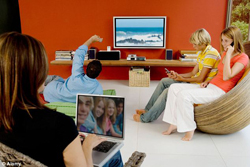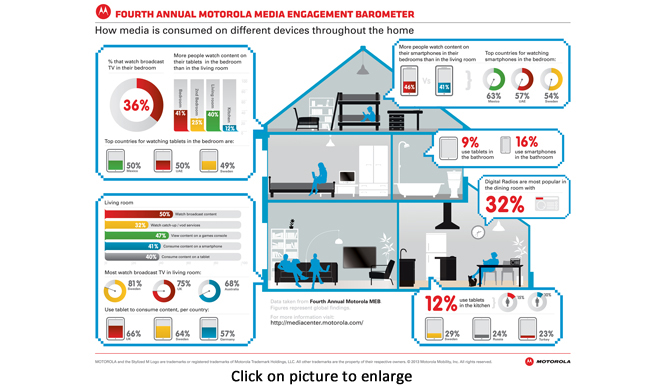Europe's online source of news, data & analysis for professionals involved in packaged media and new delivery technologies

Consumers frustrated with delivery of video content, says Motorola research
Consumers are watching an enormous amount of video, but in some surprising ways and in unexpected places, reveals Motorola Mobility's Fourth Annual Media Engagement Barometer. The study examines new and emerging content trends, such as multi-screen habits and recording behaviors. These trends reveal consumer frustration with the delivery of video content.
Key findings show that consumers around the world are watching an average of 25 hours of TV programming and film content a week. Film viewing has risen from 5 to 6 hours. TV viewing is up from 10 hours in 2011 to 19 hours this year.
Recording behaviors are now a constant of the content experience ? but content is being forgotten; almost a third (29%) of weekly TV viewing is of recorded content, but almost a third of recorded content is also never watched.
The living room remains the epicenter of the home content experience, but the multi-screen home is now a reality; the study shows the impact of Laptops, Tablets and Smartphones ? on viewing throughout the home.
Consumers want to be able to move content between devices more easily; 76% would be interested in a service that automatically loaded content a user liked to their mobile phone or tablet, to enjoy when on the move.
"This year's study shows us that consumers take their viewing experiences very seriously. They want to be firmly in control of the way they experience their videos, but they're frustrated," says John Burke, senior VP and general manager, Converged Solutions, Motorola Mobility. "Increasingly, they're using tablets and smartphones to view their content, and they expect this experience to transition seamlessly across their favorite programs, whenever and wherever they like."
The study shows that the average consumer watches 19 hours of TV content and six hours of movie content a week - totaling just over one day of content a week.
The US sees the highest consumption, with 23 hours of TV and six hours of movies watched each week. The lowest TV consumption is seen in Sweden and Japan at 15 hours and two hours respectively
The living room is the center of home entertainment consumption, but consumers are taking advantage of the ability to watch the content they like in multiple rooms throughout the home, even in unexpected places. Some 50% watch broadcast TV in the living room. The figure is highest in Sweden (81%), the UK (75%) and Australia (68%).
Also, 36% of consumers globally are watching broadcast TV in the master bedroom, and countries with above-average consumption in the bedroom include Argentina (62%), the US (54%) and Russia (49%).
Smartphones and tablets are driving most multi-room content behaviors - they are watched more than broadcast TV in the bedroom (46% and 41% versus 36%). These portable devices are also used in less-conventional rooms; 10% of tablets are used in the kitchen.
In general, tablet users could be described as 'super users:' watching more content on their own terms than non-tablet users. On average, tablet owners watch 6.7 hours of movies a week versus the average of 5.5 of non-tablet owners. Tablet users are more likely than non-tablet owners to use a service provider's TV catch-up service (47% versus 31%). A hefty 80% of a tablet user?s content is recorded, versus 65%.
Almost a third (29%) of all weekly content consumed is recorded. But live viewing still dominates - particularly with News - which is watched by 73% as it airs. Though digital video recorder (DVR) owners tend to watch an average of one hour more content a week, a third (36%) of all content recorded is never actually viewed. The US is the most wasteful content market, with 41% of recorded content never being consumed.
The study sheds light on the reasons people record content. Some 77% record because there is other content airing at the same time, which the viewer would prefer to watch live; 72% are hoarders - recording to collect the box-set, and 68% globally record to skip advertisements on commercial channels, rising to 75% and 74% in the UK and US, respectively.
With so many reasons to record content, it is understandable that the current hard drive limitations of DVRs cause frustration. Sixty-eight percent, globally, have had to delete content because they have run out of storage room on their device. Seventy-nine percent say this has caused frustration in their house. Women are more often frustrated than men by needing to remove recordings they have stored (26% versus 23%).
Consumers across the globe are storing content on devices to watch when away from home, but the study shows this experience could be made easier. Seventy-six percent would be interested in a service that automatically loaded content a user liked to his/her mobile phone or tablet, to enjoy when on the move.
Currently, 55% have downloaded or stored a TV programme or film to at least one device. Seventy-three percent of global respondents have a laptop, versus 60% and 26% who own smartphones or tablets. The majority of US (71%), UAE (79%) and Turkish (85%) respondents would be interested in such a service. Consumers in France, UK and Germany are less favorable to this opportunity, with only 50%, 47% and 41%, respectively, saying they would be interested in this sort of service.
Fifty percent of global consumers do not follow social media conversations about a TV programme on a companion device while watching a programme, but younger audiences are more inclined to interact - 60% of 16-24-year-olds do follow social conversations during programming. Some countries revealed year-on-year declines in those following social media conversation online:
The UK falls from 39% in 2010 to 24% in 2012; the US falls from 32% to 23%. However, increases were seen in Turkey, 44% in 2010 to 55% in 2012; and in the UAE, rising from 60% to 64%.
Though it appears the majority do not avidly follow online chatter, people are more likely to use social media channels to recommend content than they are to make oral recommendations (38% versus 34%). The study also shows the potential to use social media to further deepen audience interaction and sharing. Seventy-eight percent would be interested in linking their social network profile to a TV service to share what they are watching and increase online, real-time discussion.

Motorola's Media Engagement Barometer is a research project looking into the video consumption habits of 9,500 consumers across 17 markets: UK, France, Germany, Sweden, Russia, Turkey, US, Mexico, Brazil, Argentina, Australia, South Korea, Malaysia, India, Japan and China. The research was conducted on behalf of Motorola by independent agency, Vanson Bourne.
Story filed 21.03.13




















